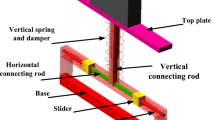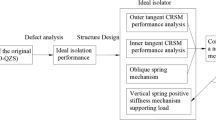Abstract
High-static-low-dynamic-stiffness (HSLDS) nonlinear isolators have proven to have an advantage over linear isolators, because HSLDS nonlinear isolators allow low-frequency vibration isolation without compromising the static stiffness. Previously, these isolators have generally been assumed to have linear viscous damping, degrading the performance of the isolator at high frequencies. An alternative is to use nonlinear damping, where the nonlinear behavior is achieved by configuring linear dampers so they are orthogonally aligned to the excitation direction. This report compares the performances of single-stage and two-stage isolators with this type of damping with the corresponding isolators containing only linear viscous damping. The results show that both isolators with linear viscous damping and nonlinear damping reduce the transmissibility around the resonance frequencies, but the results show that the isolators with nonlinear damping perform better at high frequencies.
Similar content being viewed by others
References
Lu Z Q, Chen L Q. Some recent progresses in nonlinear passive isolations of vibrations. Chin J Theor Appl Mech, 2017, 49: 550–564
Kovacic I, Brennan M J, Waters T P. A study of a nonlinear vibration isolator with a quasi-zero stiffness characteristic. J Sound Vib, 2008, 315: 700–711
Carrella A, Brennan M J, Kovacic I, et al. On the force transmissibility of a vibration isolator with quasi-zero-stiffness. J Sound Vib, 2009, 322: 707–717
Carrella A, Brennan M J, Waters T P, et al. Force and displacement transmissibility of a nonlinear isolator with high-static-low-dynamicstiffness. Int J Mech Sci, 2012, 55: 22–29
Zhang W, Zhao J B. Analysis on nonlinear stiffness and vibration isolation performance of scissor-like structure with full types. Nonlinear Dyn, 2016, 86: 17–36
Sun X T, Jing X J, Xu J, et al. Vibration isolation via a scissor-like structured platform. J Sound Vib, 2014, 333: 2404–2420
Xu J, Sun X. A multi-directional vibration isolator based on Quasi-Zero-Stiffness structure and time-delayed active control. Int J Mech Sci, 2015, 100: 126–135
Sun X T, Jing X J, Cheng L, et al. A 3-D quasi-zero-stiffness-based sensor system for absolute motion measurement and application in active vibration control. IEEE/ASME Trans Mechatron, 2015, 20: 254–262
Zhou J X, Xiao Q Y, Xu D L, et al. A novel quasi-zero-stiffness strut and its applications in six-degree-of-freedom vibration isolation platform. J Sound Vib, 2017, 394: 59–74
Xu D L, Yu Q P, Zhou J X, et al. Theoretical and experimental analyses of a nonlinear magnetic vibration isolator with quasi-zerostiffness characteristic. J Sound Vib, 2013, 332: 3377–3389
Lu Z Q, Yang T J, Brennan M J, et al. On the performance of a twostage vibration isolation system which has geometrically nonlinear stiffness. J Vib Acoust, 2014, 136: 064501
Lu Z Q, Yang T J, Brennan M J, et al. Experimental investigation of a two-stage nonlinear vibration isolation system with high-static-lowdynamic stiffness. J Appl Mech, 2017, 84: 021001
Xu Z D, Zeng X, Huang X H, et al. Experimental and numerical studies on new multi-dimensional earthquake isolation and mitigation device: Horizontal properties. Sci China Tech Sci, 2010, 53: 2658–2667
Li H, Liu D, Jiang L, et al. Self-synchronization theory of dual motor driven vibration system with two-stage vibration isolation frame. Appl Math Mech-Engl Ed, 2015, 36: 265–278
Ravindra B, Mallik A K. Hard duffing-type vibration isolator with combined Coulomb and viscous damping. Int J Non-Linear Mech, 1993, 28: 427–440
Ravindra B, Mallik A K. Stability analysis of a non-linearly damped duffing oscillator. J Sound Vib, 1994, 171: 708–716
Ravindra B, Mallik A K. Chaotic response of a harmonically excited mass on an isolator with non-linear stiffness and damping characteristics. J Sound Vib, 1995, 182: 345–353
Ravindra B, Mallik A K. Role of nonlinear dissipation in soft Duffing oscillators. Phys Rev E, 1994, 49: 4950–4954
Peng Z K, Meng G, Lang Z Q, et al. Study of the effects of cubic nonlinear damping on vibration isolations using Harmonic Balance Method. Int J Non-Linear Mech, 2012, 47: 1073–1080
Peng Z K, Lang Z Q, Meng G, et al. Reducing force transmissibility in multiple degrees of freedom structures through anti-symmetric nonlinear viscous damping. Acta Mech Sin, 2012, 28: 1436–1448
Lang Z Q, Jing X J, Billings S A, et al. Theoretical study of the effects of nonlinear viscous damping on vibration isolation of SDOF systems. J Sound Vib, 2009, 323: 352–365
Xiao Z, Jing X J, Cheng L. The transmissibility of vibration isolators with cubic nonlinear damping under both force and base excitations. J Sound Vib, 2013, 332: 1335–1354
Ho C, Lang Z Q, Billings S A. Design of vibration isolators by exploiting the beneficial effects of stiffness and damping nonlinearities. J Sound Vib, 2014, 333: 2489–2504
Tang B, Brennan M J. A comparison of two nonlinear damping mechanisms in a vibration isolator. J Sound Vib, 2013, 332: 510–520
Carranza J C, Brennan M J, Tang B. Sources and propagation of nonlinearity in a vibration isolator with geometrically nonlinear damping. J Vib Acoust, 2016, 138: 024501
Li H L, Chen Y S, Hou L, et al. Periodic response analysis of a misaligned rotor system by harmonic balance method with alternating frequency/time domain technique. Sci China Tech Sci, 2016, 59: 1717–1729
Yan Q Y, Ding H, Chen L Q. Nonlinear dynamics of axially moving viscoelastic Timoshenko beam under parametric and external excitations. Appl Math Mech-Engl Ed, 2015, 36: 971–984
Jiang W A, Chen L Q. A piezoelectric energy harvester based on internal resonance. Acta Mech Sin, 2015, 31: 223–228
Ding H. Steady-state responses of a belt-drive dynamical system under dual excitations. Acta Mech Sin, 2016, 32: 156–169
Ding H, Huang L L, Mao X Y, et al. Primary resonance of traveling viscoelastic beam under internal resonance. Appl Math Mech-Engl Ed, 2017, 38: 1–14
Li X, Zhang Y W, Ding H, et al. Integration of a nonlinear energy sink and a piezoelectric energy harvester. Appl Math Mech-Engl Ed, 2017, 38: 1019–1030
Author information
Authors and Affiliations
Corresponding author
Rights and permissions
About this article
Cite this article
Lu, Z., Brennan, M., Ding, H. et al. High-static-low-dynamic-stiffness vibration isolation enhanced by damping nonlinearity. Sci. China Technol. Sci. 62, 1103–1110 (2019). https://doi.org/10.1007/s11431-017-9281-9
Received:
Revised:
Accepted:
Published:
Issue Date:
DOI: https://doi.org/10.1007/s11431-017-9281-9




